Every classic Western movie worth its salt lick had a saguaro cactus stuck somewhere in the landscape, out yonder or sometimes in town, and then it was usually plopped in front of the saloon. They’re an iconic image, these giant, multiarmed sentinels of the desert.
Saguaros are archetypes of the Wild West, symbols of strength and survival in — as Mark Fleming, curator of botany at the acclaimed Arizona-Sonora Desert Museum, outside Tucson, says — “a challenging environment.” Indeed. Saguaros (
Carnegiea gigantea) put up with triple-digit summer heat, soak up whatever moisture their roots can salvage in an already arid land prone to drought, and on rare occasions can get dusted with snow or shiver in low-teen winter temperatures, both of which can threaten their survival.
Saguaros, the largest cacti in the U.S., grow only in the Sonoran Desert, 100,000 square miles of remarkable vistas spreading across the lower half of Arizona, a smidgen of Southern California and into Mexico. It is a lush desert, boasting 2,000 species of curious plants, the most dominant being columnar cacti, like the saguaro.
Hankering for one of your own? You’re in luck. Fall is the perfect saguaro-planting season. (Don’t live in their habitat? Small ones from nurseries can survive just fine indoors.)
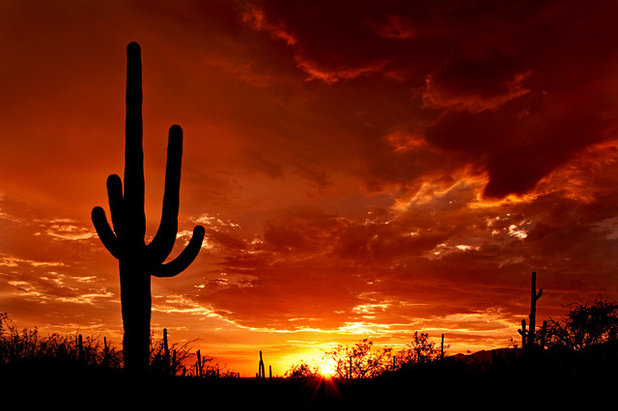 Botanical name: Carnegiea gigantea Common name:
Botanical name: Carnegiea gigantea Common name: Saguaro
Origin: Sonoran Desert (primarily in Arizona and Mexico)
Where will it grow: It’s a hardy low- and high-desert plant (sea level to 4,000 feet). Prolonged temperatures of 20 degrees Fahrenheit or below can damage or kill it. Grows in USDA zones 8a to 11 (find your zone).
Water requirement: Saguaro is primarily an outdoor plant; seasonal rainwater is preferable.
Light requirement: Full sun for mature plants; smaller transplants require shade from bushes or small trees
Mature size: Up to 50 feet
Benefits and tolerances: Drought tolerant
Seasonal interest: Flowers and fruit in spring and early summer
When to plant: Fall and into spring
The majority of saguaros in the U.S. grow in southern Arizona, where they’re protected within two national parks on the east and west sides of Tucson — the saguaros pictured here are on the east side of town.
Collectively, Saguaro National Park, east and west, is second only to the Grand Canyon in the number of annual visitors, because, like the canyon, the saguaro is worth eyeballing, especially as it matures and the characteristic arms begin to take on a life of their own — most often soaring upward but also at times curling around like a hug or dangling humorously akimbo.
Photo by Saguaro Pictures
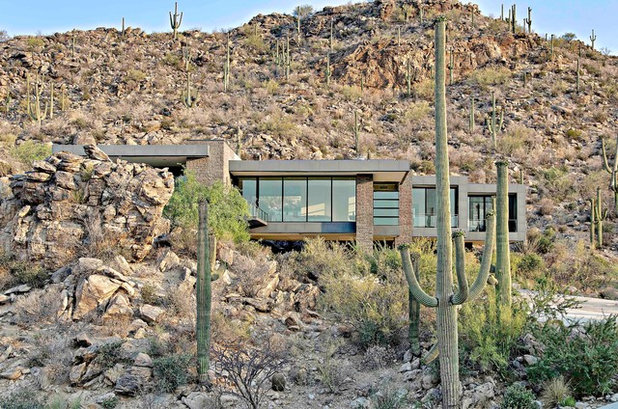
Taylordesign + BUILD
Distinguishing traits. For desert dwellers there’s nothing quite as awe inspiring as a towering saguaro. Some folks are lucky enough to live in homes that, like the one pictured here, sit in the midst of the saguaro’s habitat: the foothills, canyons and gently sloping areas of desert mountain ranges, though they’re also found in lower elevations and in yards throughout their native territory.
To have a mature saguaro in one’s landscape is a point of pride for residents of the Sonoran Desert — not only for its beauty but also for what it attracts. Like trees everywhere, the saguaro offers high-rise nesting for feathered occupants, including woodpeckers, who peck out pockets (called boots) in the saguaro’s pulpy body. When the woodpeckers abandon their boots, owls and sparrows, among others, move in. Larger birds, like hawks, nest in the curve of the arms.
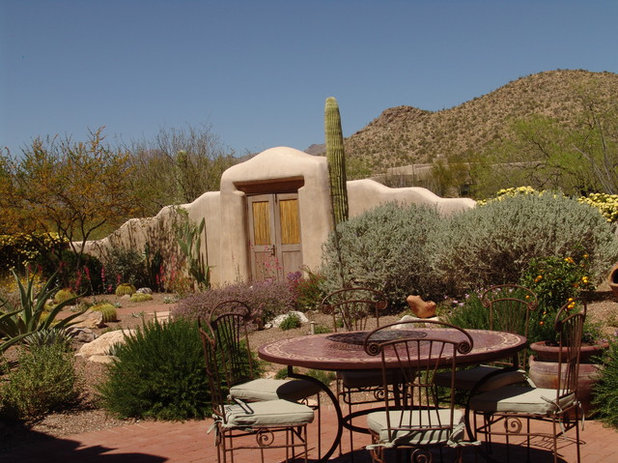
BOXHILL
If there is no naturally growing saguaro in the yard, people plant them, though the rub is that saguaros, like fine wine, are in no hurry to mature. Long lived, they have a life span estimated at upward of 200 years. At age 30 a saguaro is normally just over 2 feet tall, and it can take 60 to 100 years, depending on conditions and precipitation, for its first arms to appear. (They can have a lot of arms; one saguaro in the Saguaro National Park reportedly had 50.) Nursery-grown seedlings can grow more quickly and reach flowering stage within 15 or so years.
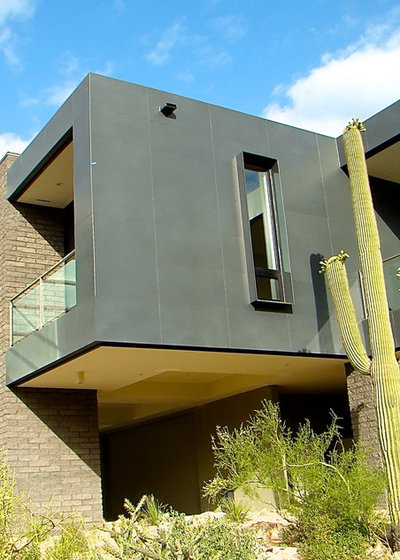
Taylordesign + BUILD
In late spring saguaros begin to produce large, creamy-white flowers — Arizona’s state flower — that grow wreath-like around the tops of the plant and its arms, as shown here on this two-story saguaro in an early blooming stage.
Bats, birds and insects handle the pollination needed to produce the fruit; coyotes and birds who eat the fallen fruit then broadcast the seeds, which can number a staggering 40 million over the plant’s lifetime (though very few of these survive).
The Tohono O’odham have long relied on the sweet saguaro fruit to make jelly and candy; today they’re delicacies among the growing number of local food enthusiasts and a favorite souvenir for tourists.
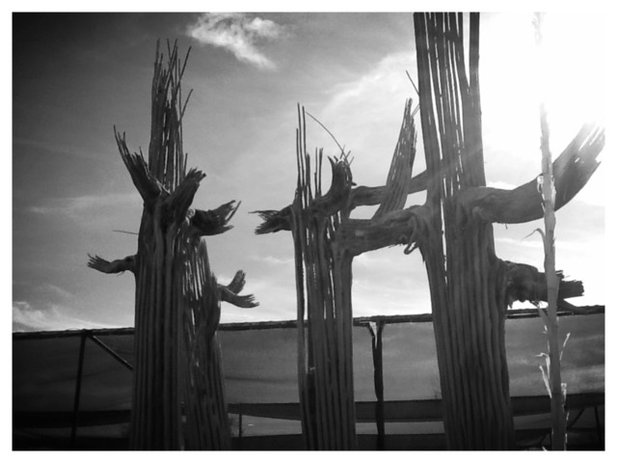
Modern Landscape
As these saguaro skeletons indicate, the plant is not “empty” but has a wood frame, or ribs, to keep it in place and upright. The saguaro and the round barrel cactus are woody desert plants, and both store water internally to help them survive — the number of ribs inside the plant corresponds to the number of pleats, or ridges, visible on the outside.
As the saguaro soaks up water, the pleats expand, accordion-style, to hold the load. It’s an efficient storage system, and it means that a saguaro, after quenching its thirst, is made up mostly of water. Water is heavy, and so are saguaros — a full-grown adult can weigh up to 7 tons. Accordingly, saguaro ribs are strong. The ancient Hohokam used them as framework for walls; today they show up in fences. Tohono O’odham fruit harvesters use ribs as poles to knock off the ripe fruit, which is also made into a ceremonial wine.
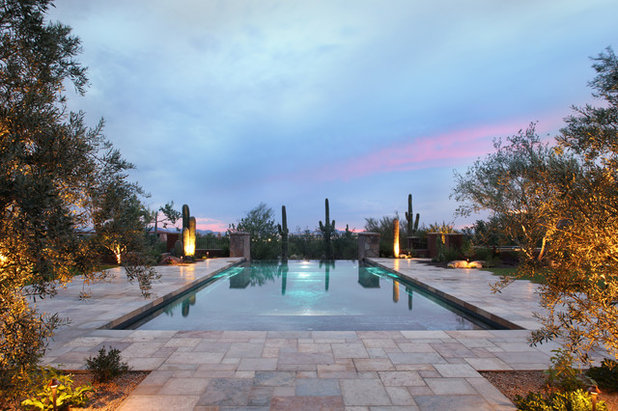
Desert Springs Outdoor Environments, Inc.
Masters of water storage, saguaros are equally adept at water gathering: saguaro roots fan out horizontally, ideally to a circumference equal to the plant’s height. The web of roots barely penetrates the surface, maybe dropping 3 or 4 inches into the soil — piping of sorts that efficiently and quickly grabs and absorbs the rain that hits ground in summer and, to a lesser degree, in winter. It also has a backup taproot, which extends a few feet down.
Weight and the well-engineered root system are key considerations when it comes to doing what saguaro-less desert homeowners do to make up for their loss: transplant one of their own, casually or as an integral element in the home design.
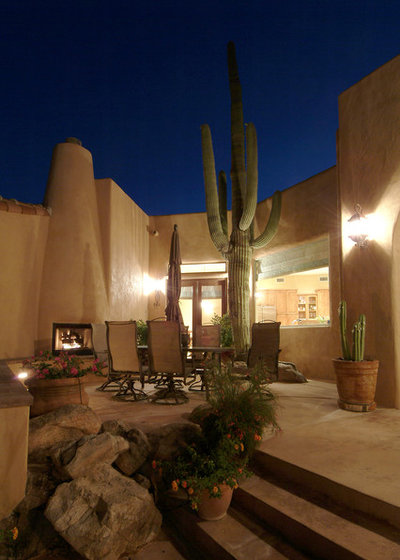
Soloway Designs Inc | Architecture + Interiors
How to use it. The saguaro is not on the endangered species list, but it is protected in Arizona; you can’t just go out into the desert and take one home. Saguaro specialists buy mature plants from landowners, which they then sell for transplanting.
A saguaro under 5 feet can be planted by a (well-protected) hand. Taller plants, especially those with arms, take a lot more effort, requiring special cradles and hydraulic lifts, backhoes, trucks and of course knowledgeable staff: That web of roots, for example, needs to be unearthed as gently and expansively as possible. Also important for transplants: ensuring that the saguaro is replanted in exactly the direction it grew naturally — or, more specifically, how it faced the sun.
Saguaros for landscaping are purchased through authorized companies, like Old Pueblo Cactus in Tucson, Arizona, a family-owned business that has been growing, buying, installing and selling saguaros and other cacti, both wholesale and retail, for 30 years.
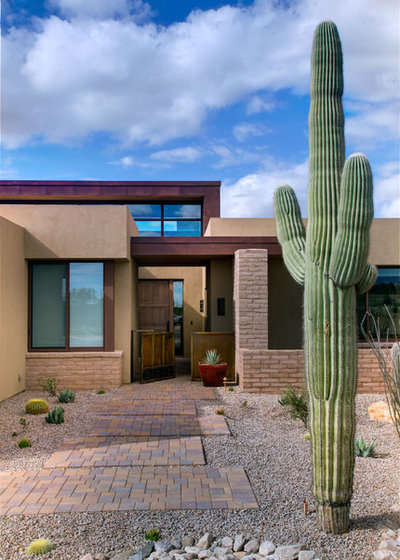
Dove Mountain Homes
Pricing at Old Pueblo, and other saguaro specialists, is based on the height of the plant and whether or not it has arms. An armless straight spear, maybe 15 years old or so, costs between $75 and $125 per foot, local installation included, at Old Pueblo. Armed saguaros cost more: a one-armed specimen, age 75 to 90 years, from Old Pueblo costs anywhere between $1,500 and $2,300, including installation, depending on circumstances — for example, if a crane is needed to place it. It takes a year to determine the success of a transplant, says owner David Hand.
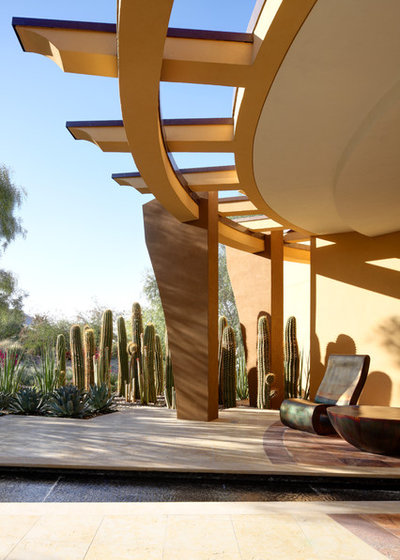
Deep River Partners
Planting notes. Summer is not the time to plant a woody cactus like the saguaro or barrel. That’s when the Sonoran Desert gets most of its rainfall, during what is officially designated as the region’s fifth season, monsoon.
Monsoon season begins in early July and ends in mid-September. (May and June are known as foresummer-drought months, according to the Arizona-Sonora Desert Museum.) “Monsoon” is an Arabic word referring to shifts in wind; a monsoon in the Sonoran Desert brings wild weather and torrential storms that can send runoff water careening down dry riverbeds and arroyos. It’s flash-flood season, and dangerous.
But the monsoon also puts on quite a show — huge cumulonimbus clouds appear on the horizon, bursting with lightning, reverberating with ear-jarring cracks of thunder. Both exciting and frightening at the same time, it offers a reward, besides the much-needed rain: the sunset. Monsoon season is the time of year when the desert sky drips in brilliant shades of red, orange and purple.
The three months of monsoon season typically provide the desert with nearly half of its 12 inches or so of annual rainfall.
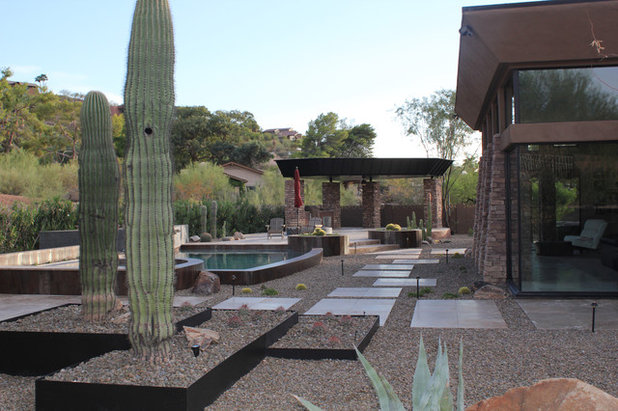
California Pools & Landscape
Spring — late February through April — is a great time to plant, but fall, after monsoon season has ended, is the optimum season. True for much of the U.S., particularly for planting natives, fall planting in the Sonoran Desert benefits from a particularly benevolent condition that helps ensure healthy growth: The soil is toasty warm after having been baked for months under the unrelenting sun. “The soil is warm, and it stays warm,” says the Arizona-Sonora Desert Museum’s curator of botany, Mark Fleming, and that warm soil promotes root growth through the winter. “It’s an ideal time to plant.”
Depending on the size of the saguaro planted, Fleming also stresses the need to include “nurse” plants like creosote bushes (
Larrea tridentata) or palo verde trees (
Parkinsonia spp), which shade young saguaros from the damaging effects of direct, punishing sunlight.
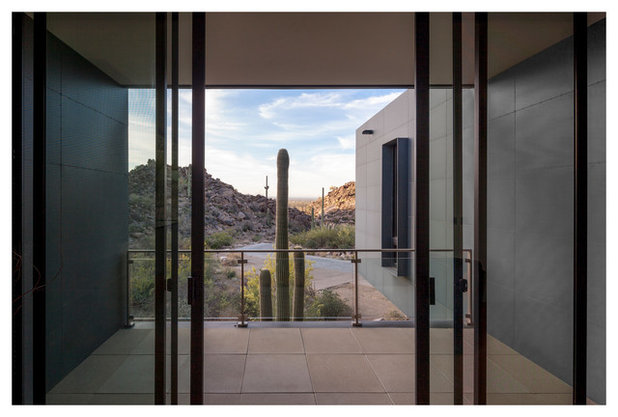
Taylordesign + BUILD
Fall is also an ideal time to buy cacti, as nurseries and organizations like the museum hold annual fall plant sales. While you probably won’t pick up a good-size saguaro at one these sales, you might find a little one — and if you don’t have the space to plant it or you’re a visitor to the area, no problem. Baby saguaros do fine indoors with the right amount of light and gentle watering.
Another reason for hitting the fall sale at the Arizona-Sonora Desert Museum is the museum itself. Opened in 1952 and located a few miles from the west-side Saguaro National Park, it is a mostly outdoor extravaganza of all things Sonoran Desert, boasting 21 acres filled with 56,000 individual plants plus another 230 native mammals, reptiles, amphibians, insects and birds. Plus, you’ll get a chance to see what museum folks have dubbed “the saguaro on wheels”: the desert tortoise — so named, says Fleming, because, like its namesake, it is a dogged, much-beloved desert survivor.
More:Let Nature Inspire Your Landscape: Devise a Desert Garden
More guides to gardening with succulents





